| Article ID | Journal | Published Year | Pages | File Type |
|---|---|---|---|---|
| 9992512 | American Journal of Orthodontics and Dentofacial Orthopedics | 2005 | 9 Pages |
Abstract
Introduction: Cone beam computed tomography (CBCT) is making headway into imaging for orthodontics. The purpose of this study was to define CBCT multi-planar reformatted projections for temporomandibular joint (TMJ) examination and compare the accuracy of linear measurements of the TMJ and related structures from these projections with similar measurements made with conventional cephalograms and with the anatomic truth. Methods: Linear dimensions between 11 anatomical sites were measured with a digital caliper to assess the anatomic truth for 25 dry human skulls. The skulls were imaged with iCAT (Xoran Technologies, Ann Arbor, Mich/Imaging Sciences International, Hatfield, Pa) CBCT, and cephalograms were made in all 3 orthogonal planes (lateral cephalometric [LC], posteroanterior [PA], and submentovertex [SMV]) acquired with photostimulable phosphor plates. Linear measurements were made on 7 custom CBCT reconstructions and the digital cephalograms. Modality means and the natural log of the standard deviations were compared post hoc against the actual dimensions by using analysis of variance with the Dunnett t test. Significance was set at P < .05. Results: All CBCT measurements were accurate; however, 3 of 5 LC measurements, 4 of 5 PA measurements, and 4 of 6 SMV measurements varied significantly from the truth. Intraobserver CBCT measurements were highly reliable compared with anatomic truth and significantly more reliable than measurements made from LC, PA, and SMV images. Conclusions: Custom oblique multi-planar reformatted reconstructions with iCAT CBCT provide accurate and reliable linear measurements of mandibular and TMJ dimensions.
Related Topics
Health Sciences
Medicine and Dentistry
Dentistry, Oral Surgery and Medicine
Authors
Michael L. Hilgers, William C. Scarfe, James P. Scheetz, Allan G. Farman,
